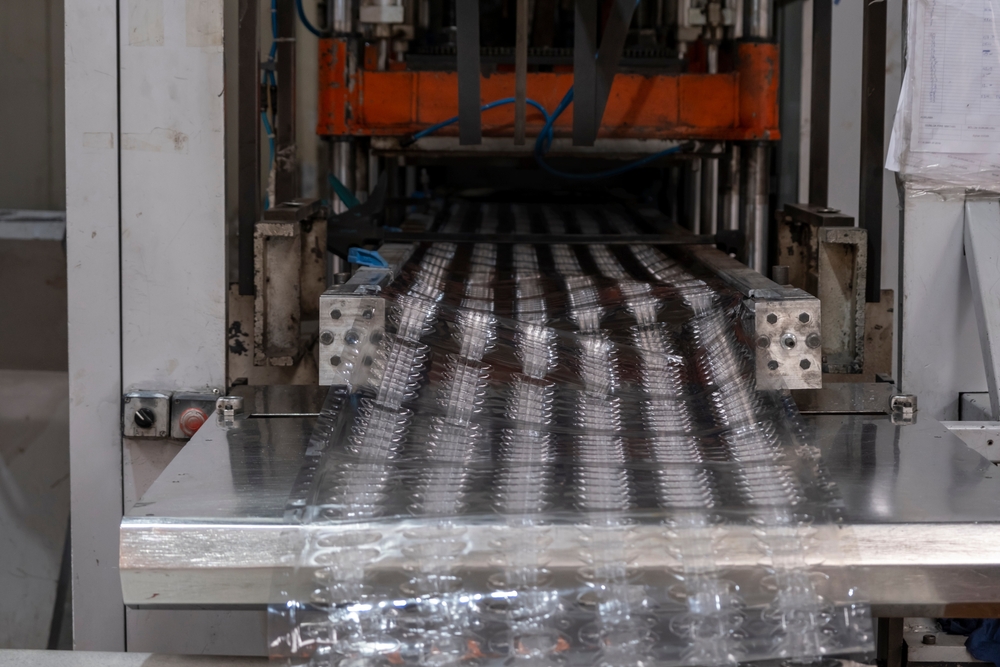When custom-shaped plastics are needed for a display, packaging solution, or material handling, thermoforming is a promising solution. This process allows you to turn sheets of plastic into unique, solid, three-dimensional shapes that can provide more advantages than standard market-variety options.
Today, we are going to cover all of the essential information that you need to know about thermoforming. From how it works to how it can be used, we will provide a complete overview to help you decide if it is a benefit for your business.
What is thermoforming?
Thermoforming is the process of heating a sheet of plastic until it becomes soft and malleable and then shaping it to fit the desired mold. The plastic is then cooled and hardened to keep its new shape. You can thermoform different types of plastics, including polystyrene, acrylic, and polycarbonate.
The thermoforming process has been used since the 19th century, but it wasn’t until the mid-20th century that it became a common manufacturing method. It’s now used to create everything from packaging materials to car parts.
How does thermoforming work?
The thermoforming process begins with a large sheet of plastic that is placed onto a male or female mold. The mold is then heated until the plastic becomes soft and malleable.
Once the plastic is pliable, it’s formed into the mold using vacuum, pressure, or both. The plastic cools and hardens in its mold, and is then removed.
The thermoforming process can be done with different types of molds, including male molds (also called plugs), female molds (also called casts), and split molds. Male and female molds are used when thermoforming products with simple or symmetrical shapes. Split molds are used when thermoforming products with more complex shapes.
Typically, thermoformed plastics are used inside of a package made with a firmer material, such as cardboard. The thermoformed plastic holds the object inside the box in place to restrict its movement until the consumer has opened it.
What are the benefits of thermoforming?
There are many benefits of thermoforming, which is why it’s such a popular manufacturing method. Some of the advantages of thermoforming include:
Custom Shapes for Retail Displays and Marketing Materials
With thermoforming, you can create custom shapes for your retail displays and marketing materials. Design unique packaging and displays that will grab attention and help your products stand out from the competition.
Better Product Protection
Thermoformed packaging is designed to protect your products from damage during shipping and handling. This type of packaging is commonly used for delicate items, such as electronics and medical devices.
Regulatory Compliance
Thermoformed packaging can be designed to meet regulatory compliance standards for your industry. This is especially important for industries that have strict packaging requirements, such as the food and beverage industry or medicine.
Because thermoformed packaging can be custom-designed to fit necessary regulatory standards, it is an incredibly diverse solution. You can use thermoforming to quickly update packaging needs as industry requirements evolve.
Increased Efficiency
Thermoforming can increase efficiency in your manufacturing process by reducing waste and scrap. This type of manufacturing is also faster and easier than other methods, such as injection molding.
Lower Chances of Product Damage
When done correctly, thermoforming can create a snug fit for your product. This decreases the chance of product damage and subsequent revenue loss during shipping and handling.
Common Thermoforming Applications by Industry
Food and Beverage
The food and beverage industry uses thermoforming for packaging products like fresh fruits and vegetables, prepared meals, and drinks. Thermoformed packaging helps to extend the shelf life of food by protecting it from damage and contamination.
Healthcare
The healthcare industry uses thermoformed packaging for a variety of applications, including medical device packaging, pharmaceutical packaging, and hospital equipment packaging. This type of packaging helps to ensure sterility and safety for patients.
Electronics
The electronics industry uses thermoformed packaging to protect delicate items during shipping and handling. This type of packaging is often used for items like computers, cell phones, TVs, and video game hardware.
Retail
The retail industry uses thermoformed packaging for a variety of applications, including displays, packaging, and signage. Because of its highly customizable nature, thermoforming can also be used to create specific shapes and designs that would otherwise be more costly or difficult.
What Is the Difference Between Thermoforming and Injection Molding?
Two prominent plastic manufacturing processes have gained widespread adoption: thermoforming and injection molding. Both techniques are vital in shaping plastic into various forms but differ significantly in their approach and applications. Let’s delve into plastic manufacturing and explore the differences between these two methods.
Thermoforming: Versatility and Cost-Effectiveness
Thermoforming is a plastic manufacturing process that involves heating a flat sheet of thermoplastic material, such as PVC or ABS, until it becomes pliable. The heated sheet is then formed over a mold using vacuum pressure, mechanical force, or both. Once the plastic cools and solidifies, it takes the shape of the mold, resulting in the final product.
Advantages of Thermoforming
Thermoforming offers remarkable design flexibility, making it ideal for creating products with complex shapes and intricate details. Its reduced tooling costs make it an attractive option for small to medium-scale production runs. Additionally, this process generates minimal material waste, contributing to cost-effectiveness.
Applications of Thermoforming
Thermoforming finds extensive use in industries like packaging, consumer goods, and automotive interiors. Its ability to produce large parts, such as trays and containers, at a lower cost makes it popular in the food packaging industry.
Injection Molding: Precision and Efficiency
Injection molding is when molten plastic is injected into a mold cavity at high pressure. The plastic cools and solidifies within the mold, taking the desired shape. Injection molding typically involves using thermoplastics, thermosetting polymers, or elastomers.
Advantages of Injection Molding
Injection molding boasts unparalleled precision and consistency, making it ideal for the mass production of intricate parts with tight tolerances. The process allows for high production efficiency, reducing cycle times and increasing output. Injection-molded parts often require minimal post-processing.
Applications of Injection Molding
The automotive industry extensively utilizes injection molding to produce various components, including bumpers, dashboards, and interior panels. Additionally, it is commonly employed in producing medical devices, toys, and electronic enclosures.
Get Thermoforming Services Today
Foam Molders & Specialties is dedicated to providing the highest-quality thermoformed plastic solutions to our customers. Our team of experts can assist you in creating the ideal solution for your needs that remains fully scalable and industry compliant. To learn more, contact us today for a quote.

